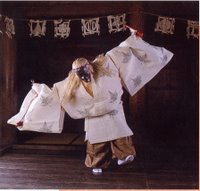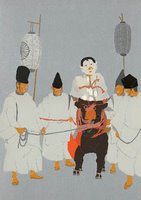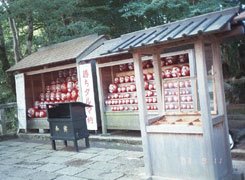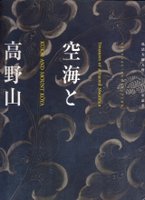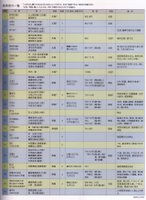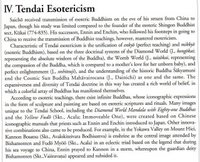[ . BACK to DARUMA MUSEUM TOP . ]
:::::::::::::::::::::::::::::::::::::::::::::::::::::::::::::::::::::::::::::::::::::::::::::::::::::
Embassies to China 遣唐使
遣唐使とは、舒明天皇2年(630)から寛平6年(894)の間に、日本から唐に派遣された公式の使節のことです。およそ20回任命されましたが、そのうち、実際に渡唐したのは16回でした
(『国史大辞典』による)。
Much of Japanese culture has its roots in China. Buddhism was first introduced around 522 via Korea and closely related to the power of the Japanese state. The Prince Shotoku Taishi (Shootoku Taishi 聖徳太子, born in 574, was a great promoter of State Buddhism and began to send embassies to China to study Chinese civilization in depth.
During the Chinese period of Sui 隋, these embassies were called “Embassies to Sui China”, kenzuishi 遣隋使, then the “Embassies to T'ang China, kentooshi 遣唐使. These embassies comprise a time period of about 260 years.
There were 5 missions to Sui China, the first started off in 607 and came back in 608. Later there were 18 or 19 to T’ang China, the last one being in 838, with the priest Ennin on board the ship. A mission planned with Sugawara no Michizane 菅原道真 in 894 was cancelled due to internal problems in China and that was the end of these missions for a while.
The main purpose of these missions was the cultural exchange and trade with China. The missions included Japanese court officials, diplomats, merchants, engineers and many Buddhist monks and scholars. They brought many innovations back to Japan, including the Chinese vocabulary that came with many new ideas. Many temples where found by monks returning from China and temple architecture was one of the main areas of the new engineering techniques. Pagodas built at that time lasted to our day, despite earthquakes and typhoons.
Many things found their way via the Silkroad, Persia, Korea and China to Japan in these days and a special museum, the Shoosoo-In 正倉院, was build in Nara, in the compound of the temple Toodai-Ji 東大寺, to hold these imperial treasures. It comprises more than 9000 items and is proof of the cross-cultural activities and cosmopolitan culture of China during the T’ang period.
Recently, in autumn of 2004, the stone epitaph of
Jing Zhencheng (a posthumous Chinese name), mentioning a Japanese person was discovered, who died at the age of 36 in China. He was one of these envoys and the discovery, announced by the Northwest University in Xian, China, is probably the oldest proof of these missions. The first mention of the name “JAPAN” on this epitaph is also remarkable. Xian was known as Chang'an during the T’ang Dynasty. (See below for details.)
The second Sui mission, led by
Ono no Imoko 小野妹子, was very successfull, on his way back he was accompanied by an envoy from China.
The third Sui mission, with Takamuko no Kuromaro 高向玄理 and the monk Soomin 僧旻 had a great influence on the Taika Reform (645) and the development of Buddhism in Japan.
The first T’ang envoy in 630 had a Chinese escort on his way back, because of political troubles with Korea.
Abe no Nakamaro 阿倍仲麻呂(698-770) left for China in 718, together with
Kibi no Makibi 吉備真備. He never made it back to his homeland and left many tanka poems about being homesick. He won the confidence of the Chinese Emperor Xuan Zong and was send to Annam as a governor.
In 803, the priests Saichoo 最澄 and Kuukai Kooboo Daishi (Kukai Kobo Daishi) 空海 弘法大師 left for China with the envoys. Both later became very important figures in promoting esoteric Buddhism in Japan. The ship of Kuukai, on his journey back, got caught in a severe storm. He threw a Buddhist pestle (sankoshoo 三鈷杵), which had been handed to him by his Chinese teacher Keika 恵果, into the sky toward the east, in the hope that it would land in an ideal place for him to begin preaching Shingon Buddhism. He later found the pestle on a pine tree in Kooyasan 高野山 in the year 816, where he then founded his famous monastery. Kuukai had also studied a lot of civil engineering and is famous for water regulating systems in Shikoku and other parts of Japan.
Kobo Daishi, Kukai, by Gabi Greve
Another legend tells this:
When Kukai was on his way back from his study trip to China in 806, his ship got caught in a severe storm. He prayed to the statue of a Fudo Myo-O to pacify the waves and behold, Fudo Myo-O thrust out his sword toward the waves, cut them and the sea calmed. This is the origin of the Wave-calming Fudo, Wave-cutting Fudo, which later became the protector deity of many seafarers and fishermen.
Namikiri Fudo Wave-cutting Fudo 波切不動尊 、浪切不動明王
Ennin Another student monk, in the footsteps of Saichoo.
Jikaku Daishi Ennin 慈覚大師仁円
Travelling to China was quite dangerous because of weather conditions, wars and pirates. The ships, called
“Ships of the Missions” kentooshi sen 遣唐使船 were rather small and many never returned. Some were shipwrecked and the envoys ended up in South-East Asian countries. The Japanese ships usually started off in Hakata/Fukuoka.
 http://www.yamaha-motor.co.jp/global/calendar/corporate/001/img/0002/pic_003.gif
http://www2.memenet.or.jp/kinugawa/ship/2200.htm
http://www.yamaha-motor.co.jp/global/calendar/corporate/001/img/0002/pic_003.gif
http://www2.memenet.or.jp/kinugawa/ship/2200.htm
http://www1.cts.ne.jp/~fleet7/Museum/Muse019.html
Ono no Imoko (小野 妹子) was a Japanese politician and diplomat in the late 6th and early 7th century, during the Asuka period.
© More in the WIKIPEDIA !
:::::::::::::::::::::::::::::::::::::::::::::::::::::::::::::::::::::::::::::::::::::::::::::::::::::::
Later emissionaries and students of Buddhism
INGEN
brought sine beans from China.The
ingen mame gets its name from the priest Ingen who brought the beans (ingen mame 隠元豆) from China in the 16th century.
EISAI
Eisai Zenji 栄西禅師 (1141-1215), a Japanese monk, founded the Rinzai school of Zen Buddhism after studying with the T'ien-T'ai school in China. He is also with credited with bringing tea from China and thereafter
initiating the Japanese Tea Ceremony.
http://buddhism.about.com/cs/zen/g/Eisai.htm
Eisai (April 20, 1141–July 5, 1215)
Eisai-Ki 栄西忌 Eisai Memorial Day
Kennin-Ji Kaisan Ki 建仁寺開山忌(けんにんじかいさんき)
kigo for late summer
. Memorial Days and Kigo .
. Kennin-ji (建仁寺) .
.................................................................................
. Genbo 玄昉(げんぼう Genboo).
(? - 746)
.................................................................................
As readers of Chinese, some Buddhist monks became expert in administration and technical matters, such as engineering, and these
monks served Japan much as the Latin reading clergy served in medieval Europe.
Read an interesting article:
Japan, Buddhism and Warlords. Frank E. Smitha.
:::::::::::::::::::::::::::::::::::::::::::::::::::::::::::::::::::::::::::::::::::::::::::::::::::::
Exhibition at the Nara Museum

From the seventh until the late ninth century, Tang was the greatest and most advanced power in East Asia. The Japanese envoys whom were dispatched on a dozen or more occasions in order to study the social and political systems of Tang and its culture made enormous contributions to ancient Japan, and the discovery for the first time of an epitaph associated with one of them is a historic event.
The inscription, moreover, makes the first known use of the Chinese characters for the name "
Japan" that are still employed today.
Exhibition
September 20 (Tue) - October 10 (Mon), 2005
http://www.narahaku.go.jp/exhib/2005toku/kentoshi/kentoshi-1_e.htm
Epitaph about a China Ambassador
This find reminds us of what Japan-China ties could be.
The news that broke in China was at first hard to believe. Northwest University in Xian, known as Changan during the Tang Dynasty (618-907), announced the discovery of a stone epitaph to a Japanese student who died there early in the eighth century. The man was a kentoshi, or envoy, to the imperial court. He was 36 when he died.
Inscribed on a small stone tablet that would have been placed at the gravesite, it records the man's name and title. It noted that he was appointed a bureaucrat for his diligence, and was posthumously conferred high bureaucratic status by Emperor Xuanzong who mourned his death.
The Chinese name given him was Jing Zhencheng, possibly after his Japanese family name that was either Inoue or Fujii.
This is the first such record of a Japanese envoy ever discovered in China from that period. The inscription is so clear it's hard to believe it dates back more than 1,200 years.
What also makes this discovery exceptionally valuable is that this might be the oldest existing material that mentions Japan by the name it is known today.
The accepted theory among scholars of ancient history is that the country name of Japan gained currency in the late seventh century when the word emperor had become an established title. In Japan, however, the oldest discovered documentation that refers to the nation by this name is a report written by a bureaucrat in the mid-eighth century.
Also meaningful is that the Xian discovery confirms China, an advanced nation in the ancient world, was referring to Japan as Nihon or Nippon rather than Wei.
Japan sent envoys to the Tang Dynasty court to learn the culture of the continent and world affairs. The ancient China accepted Japan and treated Japanese envoys so graciously as to fashion an impressive stone tablet to record the life of one such Japanese. We see in that bygone era what the Sino-Japanese relationship really should be.
Among the Japanese envoys who never returned home, perhaps the best-known is Abe no Nakamaro (698-770), who was taken into Emperor Xuanzong's confidence. Abe tried to come home once, but a shipwreck forced him to return to Changan. He expressed his homesickness in this tanka poem: Behold, the moon now rises high and clear/ The selfsame moon that people see at Kasuga/ My home, appearing from behind Mount Mikasa.
Jing Zhencheng is believed to have gone to China on the same ship as Abe in 717. Did the two men live similar lives? One wonders what thoughts might have crossed their minds as they lay dying, knowing they would never go home as returning heroes.
The news from Xian may have reminded many people of
Tempyoo no Iraka (The roof tile of Tempyo), a novel by Yasushi Inoue that was also made into a movie. It is the story of young Japanese student monks who risked their lives to go to China to establish the foundations of Buddhism in Japan. After all sorts of trials and tribulations, some succeeded in bringing Jianzhen, a high priest, back to Japan, while others never made it back home and lived out their lives on foreign soil.
Northwest University was where Japanese students were attacked last year by their Chinese counterparts who took offense to a cultural festival performance by the Japanese students.
Ikuo Hirayama, president of Tokyo National University of Fine Arts and Music, was present when the Northwest University discovery was announced. He commented to the effect that the Japanese student in ancient China must have
returned to the present day to remind us to learn from the history of bilateral goodwill and friendship.
Stone epitaphs recording the lives of the deceased were very much part of Chinese culture and history. Many such artifacts continue to be unearthed around China. It is exciting to imagine those for Abe and other Japanese being discovered some day.
--The Asahi Shimbun, Oct. 13(IHT/Asahi: October 14,2004) (10/14)
http://www.asahi.com/english/opinion/TKY200410140130.html
::::::::::::::::::::::::::::::::::::::::::::
Ships used by the Kentooshi
Kentooshisen Kentoshisen
For around 260 years, between 630 and 894 AD, 16 groups of Japanese envoys were sent out from Japan to China (a total of 19 times) in order to collect information regarding life overseas, and study progressive cultural and technical issues. The ninth group of envoys, in 717 AD, was joined by elite scholars such as Abeno Nakamaro and Kibino Makibi. The twelfth returning ship (in 753) brought Ganjin wajo, who made a great contribution to the rise of Buddhism in Japan. Other travelers were Saicho and Kukai, who traveled on the 18th voyage (in 804), and were extremely active as the spiritual leaders of their age. It appears that the Japanese taste for learning and discovering new things is not a new phenomenon.
There are, however, no historical documents that show specific details of how the boats of the time looked. As a result, the diagrams and models of envoy ships that appear in textbooks and museums are based merely on assumptions by later generations. The illustration for January is based on the 11th century manuscript entitled 'Pictorial history of Shotoku Taishi', to which I have added some arrangements that struck me as appropriate. The ship's structure is such that inner walls have been added, layer by layer, with decorative panels at the sides, which stretch from front to back; there are two masts that carried square sails, and the ship can be rowed when there is no wind.
The ship is similar to later type junks, and this is how most scholars recreate such ships, with bamboo floats to prevent capsizing. For a layman, though, the thing that really stands out in regard to these ships is the colors - as though they were a Chinese Buddhist temple, they are colored in red, white and green. This coloring, which reminds people of 'Ryugu', an undersea castle in a famous fairy tale, and the gorgeous superstructure, which looks very special, bring out all the romance of the envoy ships.
In fact, the journey to the envoys' destination, Changan, was a treacherous one, with a minimum sea journey of 800km from Kyushu, and a further 1200km to be crossed on land. A single envoy party comprised between 240 and 550 people, and the envoys would depart Japan in groups of two to four boats during the period between spring and early summer, in order to arrive in line with the visiting season. Of the sixteen voyages- a total of 48 boats - it is said that 12 boats perished (with a total of 25% of the boats wrecked!).
From the 8th voyage onwards, due to worsening conditions in the Korean peninsula, the land routes (north routes) became unavailable, and the more dangerous southern routes became the only way to travel to China. This, and the lack of skills in terms of both shipbuilding and sailing, could account for the losses, but it is difficult to imagine the conditions that must have prevailed during those 260 years. It is extraordinary to think that it took a further 500 years before Japan's large ships achieved the level of experience necessary to establish relatively safe seafaring.
It is a kind of conceit for people living today, however, to be surprised at the fact that the basic technologies have not evolved significantly over a period of several hundred years. The wheel was invented more than 3000 years before the birth of Christ, but cars today still use the same basic structure to move. People have dreamed of flying since human beings walked the earth, but this has only become possible within the last 100 years.
Technology will not progress naturally without basic research being carried out, but at the same time, it does not necessarily progress in a way that is purely logical. It is affected largely by the resources available and the natural environment in which it is operating. Anyone can look at something another achieved and criticize it or imitate it in retrospect, but surely it is important that we learn to first take up the challenge of the unknown, like the envoys of old, and build on our experience, in order to meet the challenges of the age.
http://www.yamaha-motor.co.jp/global/calendar/corporate/001/0002.html
:::::::::::::::::::::::::::::::::::::::::::::::::::::::::::::::::::::::::::::::::::::::::::::::::::::
Food along the Silk Road
Food is one of the items that traveled along the Silk Road. It was adapted by different countries in different ways. Noodles are known in almost every country along the Silk Road. Where did pasta originate? Food historians say probably in Persia. Flat bread known as pita in Armenia became puri in India. Chinese dumplings and stir-fry rice are similar to Italian ravioli and risotto.
http://www.fotuva.org/news/silk_roads.html
:::::::::::::::::::::::::::::::::::::::::::::::::::::::::::::::::::::::::::::::::::::::::::::::::::::
Online Material
Shotoku-taishi
Epitaph of Jing Zhencheng (Stone)
http://www.narahaku.go.jp/exhib/2005toku/kentoshi/kentoshi-1_e.htm
List of Japanese Pilgrims to CHINA
http://academic.hws.edu/chinese/huang/mdln210/pilgrims.htm
Shoosoo-In
http://aris.ss.uci.edu/rgarfias/gagaku/shosoin.html
http://web-japan.org/atlas/historical/his13.html
The Era of the Kentoshi (Japanese Envoys to Tang Dynasty China)
http://www.asean.or.jp/AJ2003/html/english/history.html
Japanese Culture
http://www.issho.org//modules.php?op=modload&name=News&file=article&mode=
flat&order=0&sid=1114
Long article about Japanese early history
http://www.san.beck.org/3-11-Japanto1615.html
The Founding of Dazaifu, Bruce Batten
More Resources from Catalogs, Gabi Greve
:::::::::::::::::::::::::::::::::::::::::::::::::::::::::::::::::::::::::::::::::::::::::::::::::::::
Kibi no Makibi 吉備真備 (695 – 775)

Kibi no Makibi (吉備真備 695–775) was a Japanese scholar and noble during the Nara period. Also known as Kibi Daijin. Born in Bitchu Province (present-day Kurashiki, Okayama Prefecture) as Shimotsumichi Asomi, he came from a line of local elites. Kibi was the name of the town or area he came from.
In 716, he traveled to China to study, and is supposed to have brought back a number of things, introducing to Japan for the first time the game of go, the art of embroidery, and the biwa (a kind of lute). He became famous for these journeys in China with Abe no Nakamaro and the monk Genbō.
In 737, he received promotion to the junior fifth rank. In 751, at the senior fourth rank (upper grade), he received an appointment as vice-ambassador to the T'ang Dynasty and traveled to China the following year, returning to Japan in 753.
After spending some years in Kyūshū as the assistant administrator of Dazaifu (the principal governmental post on that island), he returned to Nara for appointment in 764 to the leadership of the project to construct Tōdai-ji. Promotion to the junior third rank followed, as well as appointment to head an army to put down the uprising by Fujiwara no Nakamaro. Reaching the second rank in 765, he took the offices of Major Councillor, then Minister of the Right. In 770, he supported a losing candidate for the throne and submitted his resignation from office, but the court accepted only his resignation from military office, and retained him as Minister of the Right. He finally resigned in 771, devoting himself to the study of Confucian principles and their applications in Japanese administration. Kibi died in 775.
Kibi has sometimes been credited with inventing the
katakana phonetic syllabary and writing system.
吉備大臣入唐絵 Kibi Daijin Nyuto E
A late 12th century
narrative handscroll in the collection of the Museum of Fine Arts, Boston depicting Kibi's journey to China is one of the earliest of all Japanese narrative pictorial handscrolls (e-maki) known to be extant. It is believed to have been commissioned to help support the prestige of a school of divination which claimed connections to Kibi. Its purchase by the museum in 1932 directly led to the strengthening of Japanese laws against the removal of cultural properties of particular importance from the country.
© More in the WIKIPEDIA !
- - - - - detail of the scroll with an Oni demon
When Abe no Nakamaro was sent to China, he died there and became an Oni.
When Kibi no Makibi went to China and was in trouble, this Japanese Oni came to his help.

 . Onipedia - 鬼ペディア - Oni Demons - ABC-List - Index - .
- - - - - This Oni is also on the cover of a book:
. Onipedia - 鬼ペディア - Oni Demons - ABC-List - Index - .
- - - - - This Oni is also on the cover of a book:
 Japanese Demon Lore:
Japanese Demon Lore:
Oni from Ancient Times to the Present
Noriko Reider
 吉備大臣入唐絵巻知られざる古代中世 一 千年史
吉備大臣入唐絵巻知られざる古代中世 一 千年史
倉西裕子 Kuranishi Yuko (1963 - )
:::::::::::::::::::::::::::::::::::::::::::::::::::::::::::::::::::::::::::::::::::::::::::::::::::::
Ambassadors from the Island of Immortals:
China-Japan Relations in the Han-Tang Period
(Asian Interactions and Comparisons)
Zhenping Wang

Using recent archaeological findings and little-known archival material, Wang Zhenping introduces readers to the world of ancient Japan as it was evolving toward a centralized state. Competing Japanese tribal leaders engaged in "ambassador diplomacy" and actively sought Chinese support and recognition to strengthen their positions at home and to exert military influence on southern Korea. They requested, among other things, the bestowal of Chinese insignia: official titles, gold seals, and bronze mirrors. Successive Chinese courts used the bestowal (or denial) of the insignia to conduct geopolitics in East Asia.
source : www.amazon.com
:::::::::::::::::::::::::::::::::::::::::::::::::::::::::::::::::::::::::::::::::::::::::::::::::::::
. Koorokan 鴻臚館 Koro-Kan, Chinese Guesthouses .
for embassies from China and for Japanese on their way to China
[ . BACK to DARUMA MUSEUM TOP . ]
[ . BACK to WORLDKIGO . TOP . ]
- #kentoshi #abenonakamaro #kibinomakibi -
:::::::::::::::::::::::::::::::::::::::::::::::::::::::::::::::::::::::::::::::::::::::::::::::::::::

